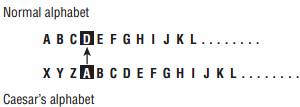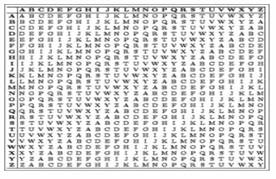Before the modern era, cryptography was concerned solely with message confidentiality (i.e., encryption)—conversion of messages from a comprehensible form into an incomprehensible one and back again at the other end, rendering it unreadable by interceptors or eavesdroppers without secret knowledge (namely the key needed for decryption of that message). Encryption was used to (attempt to) ensure secrecy in communications, such as those of spies, military leaders, and diplomats.
The earliest forms of secret writing required little more than writing implements since most people could not read. More literacy, or literate opponents, required actual cryptography. The main classical cipher types are transposition ciphers, which rearrange the order of letters in a message (e.g., ‘hello world’ becomes ‘ehlol owrdl’ in a trivially simple rearrangement scheme), and substitution ciphers, which systematically replace letters or groups of letters with other letters or groups of letters (e.g., ‘fly at once’ becomes ‘gmz bu podf’ by replacing each letter with the one following it in the Latin alphabet).
The Greeks of Classical times are said to have known of ciphers (e.g., the scytale transposition cipher claimed to have been used by the Spartan military). Steganography (i.e., hiding even the existence of a message so as to keep it confidential) was also first developed in ancient times. After the discovery of frequency analysis perhaps by the Arab mathematician and polymath Al-Kindi (also known as Alkindus) in the 9th century, nearly all such ciphers became more or less readily breakable by any informed attacker.

Substitution cipher  Vigenere cipher
Vigenere cipher
With the development of the polyalphabetic cipher, by Leon Battista Alberti around the year 1467, used different ciphers (i.e., substitution alphabets) for various parts of a message (perhaps for each successive plaintext letter at the limit). He also invented what was probably the first automatic cipher device, a wheel which implemented a partial realization of his invention. In the polyalphabetic Vigenère cipher, encryption uses a key word, which controls letter substitution depending on which letter of the key word is used. In the mid-19th century Charles Babbage showed that the Vigenère cipher was vulnerable to Kasiski examination, but this was first published about ten years later by Friedrich Kasiski.
With the invention of polyalphabetic ciphers came more sophisticated aids such as Alberti’s own cipher disk, Johannes Trithemius’ tabula recta scheme, and Thomas Jefferson’s multi cylinder (not publicly known, and reinvented independently by Bazeries around 1900). Many mechanical encryption/decryption devices were invented early in the 20th century, and several patented, among them rotor machines—famously including the Enigma machine used by the German government and military from the late 1920s and during World War II. The ciphers implemented by better quality examples of these machine designs brought about a substantial increase in cryptanalytic difficulty after WWI.
In the United Kingdom, cryptanalytic efforts at Bletchley Park during WWII spurred the development of more efficient means for carrying out repetitious tasks. This culminated in the development of the Colossus, the world’s first fully electronic, digital, programmable computer, which assisted in the decryption of ciphers generated by the German Army’s Lorenz SZ40/42 machine.
Extensive open academic research into cryptography is relatively recent; it began only in the mid-1970s. In recent times, IBM personnel designed the algorithm that became the Federal (i.e., US) Data Encryption Standard; Whitfield Diffie and Martin Hellman published their key agreement algorithm; and the RSA algorithm was published in Martin Gardner’s Scientific American column.
Essentially, prior to the early 20th century, cryptography was chiefly concerned with linguistic and lexicographic patterns. Since then the emphasis has shifted, and cryptography now makes extensive use of mathematics, including aspects of information theory, computational complexity, statistics, combinatorics, abstract algebra, number theory, and finite mathematics generally.
Cryptographic Algorithms Types
There are several ways of classifying cryptographic algorithms like categorization based on the number of keys that are employed for encryption and decryption, defined by their application and use. The three types of algorithms that are usually classified into are
- Secret Key Cryptography (SKC) – Uses a single key for both encryption and decryption
- Public Key Cryptography (PKC) – Uses one key for encryption and another for decryption
- Hash Functions – Uses a mathematical transformation to irreversibly “encrypt” information

